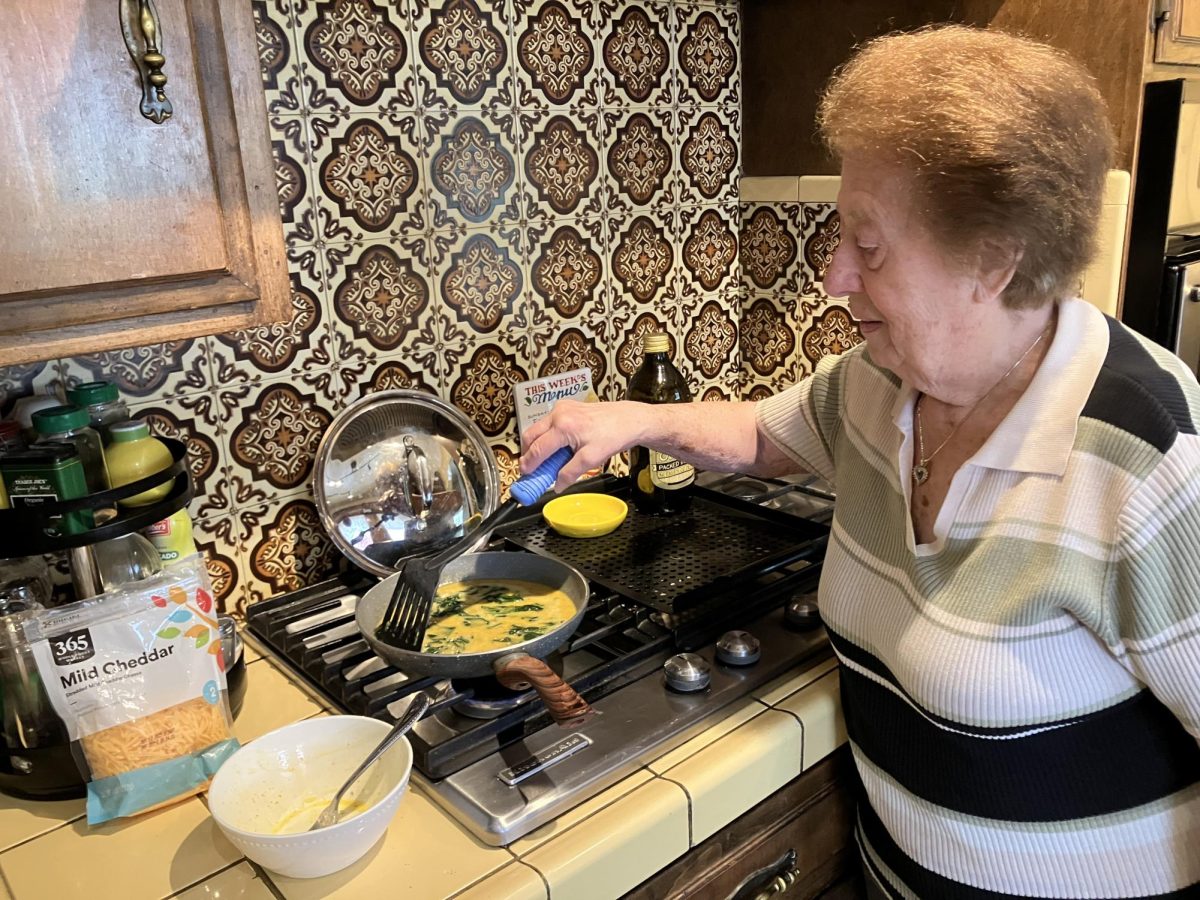How to…

A scrambled egg is one of the simplest meals you can make on a stovetop. All you need are a couple of eggs, some optional vegetables or cheese, and the basics of a kitchen to make a solid scramble.
However, to perfect your eggs, you don’t need expensive ingredients or cookware, you need the right technique. While there are many different scrambling techniques from different cultures, my grandma, a cooking-lover for decades, has perfected her own scrambled eggs that I have adopted and modified for my weekend-morning breakfasts.
First, you need patience. You can’t decide to make eggs in the morning and think it’s going to take the same amount of effort as putting some milk into cereal, or the other way around if you are one of those people.
“Always be organized” my grandma says. “It’s the most important thing.” Start by retrieving everything you’re going to need, and set everything up in an orderly fashion. Remember, you’re not just cooking eggs, you’re using your kitchen. Chop up your veggies, put your eggs aside, and have your cheese, salt, and tableware laid out in an accessible place.
Start by sauteing your vegetables in a pan on medium heat. “Olive oil is the best” for scrambled eggs, says Susan, my grandma. You can cook them for however long you need, but the hotter your pan gets, the faster your eggs will cook, which isn’t optimal.
Meanwhile, crack as many eggs in a bowl, and scramble them with onion powder or salt.
After the veggies have been sauteing for a minute or two, turn off the heat, allowing the pan to cool. This will let the eggs cook slower once they go in, resulting in a creamier texture.
Pour in your eggs on low heat, and scrape the edges inwards when they start to solidify. Make sure the eggs aren’t stagnant for too long so they cook evenly.
Switch the heat from low to medium heat every 30 or so seconds so the eggs will cook evenly and slowly.
Layer on your cheese when your eggs are solid but still liquid-y, then mix the cheese into the eggs with a spatula.
Lastly, take your eggs out of the pan when they’re cooked to your liking. Preferably they are not 100% solid but close to it. “Then comes the cleanup,” my grandma tells me, as it is the most important part.
Flying looks effortless from the ground, just a smooth ascent, a graceful glide, and a gentle touchdown. But in the cockpit, it’s a delicate balance of skill, focus, and trust in the machine.
“The first step is understanding that an airplane wants to fly,” says Steve Schwartz, an aircraft salesman and pilot. “Your job is to guide it, not fight it.” That starts before you even take off. A good pilot performs a thorough pre-flight check—fuel levels, control surfaces, instruments—all ensuring the aircraft is ready to go.
Once in the pilot’s seat, secure your seatbelt, adjust your headset, and go through your pre-flight checklist. “A lot of people think flying is about instinct, but it’s really about discipline,” Schwartz says. “You don’t just ‘feel’ your way through—it’s a structured process.” After confirming the runway is clear, apply the throttle smoothly, and as the plane gains speed, gently pull back on the yoke. “You’re not yanking it into the air. Let it lift naturally.”
At altitude, the key is small, steady adjustments. “The biggest mistake new pilots make is overcorrecting,” Schwartz explains. “If the nose dips, don’t yank it up—just ease back a little.” Keeping an eye on airspeed, altitude, and heading helps maintain control, but the real skill is in feeling the plane’s response and making tiny tweaks to keep it steady.
Landing, often called the hardest part of flying, is about precision and patience. “A good landing starts miles before the runway,” Schwartz says. Reduce power, set up your descent, and maintain a steady glide path. As the ground rises to meet you, gently pull back on the yoke to flare—letting the wheels kiss the pavement. “If you do it right, it should feel like nothing at all.”
Flying, like anything worth mastering, takes practice. But as Schwartz says, “Once you get it, there’s nothing like it. Freedom, perspective—it’s magic.”
The question we all face at some point is, “Where do I go to college?” While getting accepted is a huge part of the process, that’s just the tip of the iceberg. It’s about applying to and ultimately choosing the place that feels right for you.
This past year, I’ve been navigating the ups and downs of the college admissions process. From writing countless essays to waiting anxiously for decisions, it’s been a whirlwind of emotions.
Even though I’ve gained a lot of insight through my own experience, I know I’m far from being an expert, so I reached out to Ms. Hedgspeth, one of our amazing college counselors at de Toledo, for her perspective. She emphasized, “Students often focus on the ranking or prestige before thinking about the school’s fit as a whole.”
Her words really stuck with me. It’s easy to get caught up in aiming for a school with a big name or a high ranking, but Ms. Hedgspeth reminded me that choosing a college is about more than that. It’s about considering factors like the class sizes and extracurricular opportunities. Especially coming from a smaller school like de Toledo, you need to think about what it’s going to be like in a large lecture hall.
In the end, the decision isn’t just about the classes you take, it’s also about “your life outside of the classroom.” Ms. Hedgspeth also highlights the importance of thinking about the kind of environment you want to be in. Do you want to be in a bustling big city or quiet town? Do you care about school spirit and game days? Even things like the weather shape your experience.
Ultimately, it’s about where you’ll be the most happy and successful, not prestige or rankings. It’s not about the best college you get into, it’s about picking the best college for you.
Modern cars use automatic transmission. This means that the car automatically knows which gear, or which one of six modes of car acceleration, to use. However, some cars still require the driver to manually switch from one gear to the next.
Gears are organized in a car just like they are for a bicycle: the first gear has the lowest top speed and the highest acceleration while the sixth gear has the highest speed and lowest acceleration.
To turn on stick shift cars, press the clutch (the extra pedal on the car to the left of the brake) and the on-button simultaneously. To actually move the car, press the clutch and shift the stick into first gear.
However, the foot must not leave the clutch immediately. The foot must slowly release from the clutch or else the car will stall out (meaning that the driver will have to restart the car and do the whole process again). “Ease up on the clutch while giving it gas in first gear,” says Joshua Schank (my father), who owns and drives a BMW with manual transmission. The gas pedal is not necessary to shift into first, but it can help. As the foot slowly releases from the clutch in the first gear, the car will move forward. If you can successfully remove your foot from the clutch without stalling the car, then you know that you have entered the first gear. Once fully in first gear, the car will begin to move regardless of whether or not the foot is on the gas pedal.
The first gear is always the most difficult to enter. Once the car is in first gear, it can accelerate quickly, but if it goes too fast, the engine may be overwhelmed. In order to go faster, you must shift to higher gears by pressing the clutch and moving the stick to the corresponding gear. Since the car is already moving, stalling out is very unlikely. After the car gains speed and the car’s RPM (shown on the dashboard to the left of the speedometer) begins to approach 3000-4000 Revolutions per Minute, switch to the second gear, then the third gear, until the car is in gear six.
Gear six is not recommended unless you are on a road where you can safely reach high speeds. For driving on streets, the third and fourth gears are recommended.
In order to stop the car without stalling out, press the clutch, shift into neutral, and then brake. One can stop the car while it is in gear, but the car will stall out in the process.
Driving stick shift may be difficult for some and easier for others. Is it a dying art for an obsolete method of driving? Probably, but is it also kinda fun to learn? Definitely.










